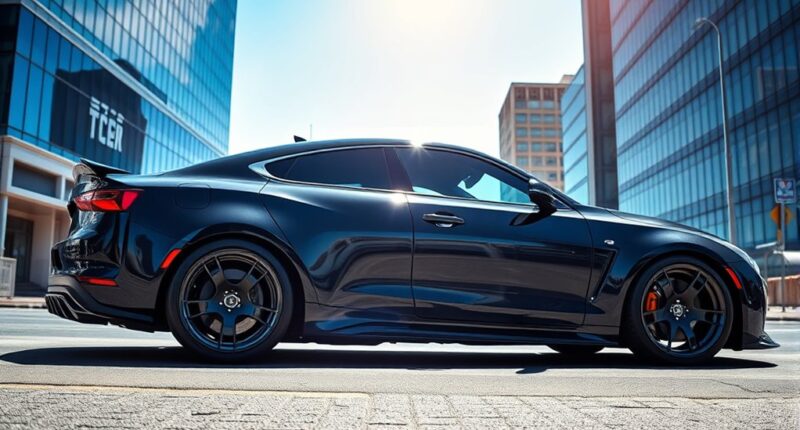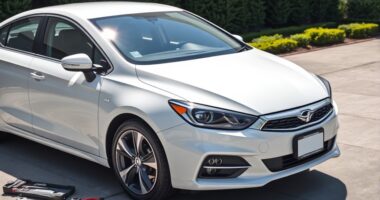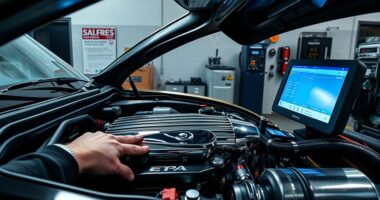Vehicle tuning in the US is legal as long as your modifications meet federal safety, emissions, and noise standards, and comply with state-specific laws. You need to prevent disabling safety features, tampering with emissions controls, or exceeding noise limits. Many states have restrictions on lighting, tinting, and suspension changes. Staying within these rules helps you avoid fines or vehicle issues. To guarantee your upgrades are legal and safe, understanding these regulations is essential—there’s more you should know before you start customizing.
Key Takeaways
- Vehicle tuning must comply with FMVSS safety standards to remain legal on public roads.
- Emissions modifications are restricted; defeat devices and unapproved calibrations can lead to fines.
- State laws vary, regulating lighting, bumper heights, tinting, and noise levels, affecting tuning legality.
- Safety features must remain operational; disabling airbags or safety systems is generally illegal.
- Proper documentation and adherence to manufacturer guidelines help ensure modifications stay within legal limits.
Federal Regulations Impacting Vehicle Modifications
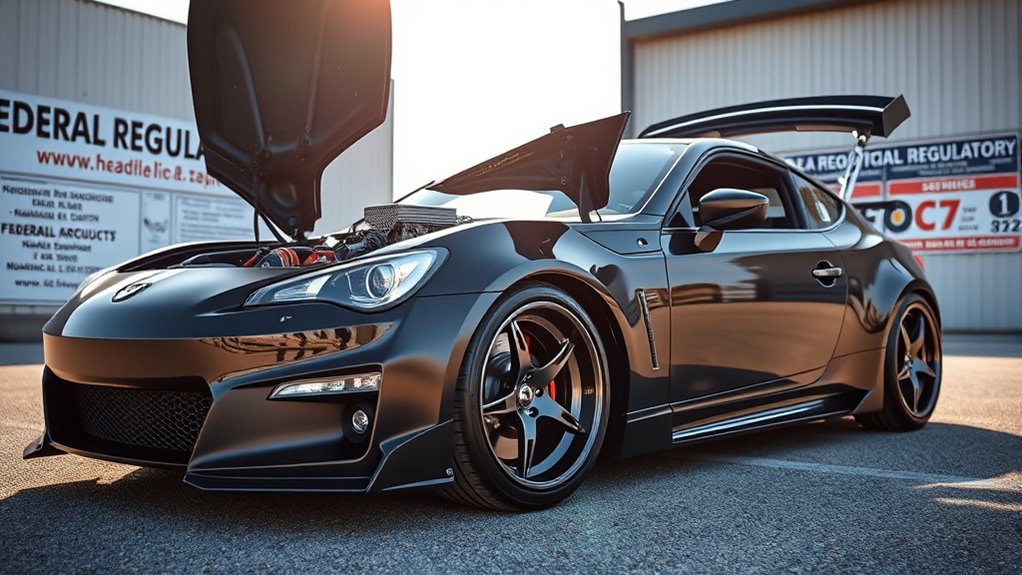
Federal regulations play a crucial role in shaping how you can modify your vehicle. The Federal Motor Vehicle Safety Standards (FMVSS), enforced by NHTSA, set safety requirements for crashworthiness and crash avoidance.
Additionally, the Environmental Protection Agency (EPA) regulates emissions, ensuring that modifications don’t harm air quality.
If you’re making accessibility modifications for disabled individuals, certain safety standards may be exempted under specific conditions, but labeling and documentation are required to prove compliance.
Legislation like 49 CFR § 595.7 allows exceptions for accessibility modifications, while laws such as 49 U.S.C. 30122 prohibit disabling safety features unless explicitly permitted.
Staying within these federal regulations is essential to avoid penalties and ensure your modifications remain legal on public roads.
State-Specific Laws and Restrictions

Laws governing vehicle modifications can vary considerably from state to state, affecting what you’re allowed to do on public roads. Some states require specific bumper heights or fender clearances, while others restrict certain lighting, like red or blue emergency lights. Many states also have specific regulations regarding the use of aftermarket wheels and tires, and failure to comply can result in citations. Tint laws differ widely; for instance, California enforces stricter front window limits, and rear window tint varies from 20% to 35%. Noise regulations also vary, with decibel thresholds from 80 to 95 dB, and some states ban neon underglow lighting altogether. Many states restrict decorative license plate covers or frames that obscure registration. Additionally, laws may enforce vehicle inspections after modifications, impose fines, or confiscate equipment. Understanding state-specific vehicle laws is crucial for responsible modification practices. Moreover, some states require comprehensive vehicle registration to reflect modifications, ensuring legal compliance. Be aware that some modifications, such as NOS systems or rolling coal devices, are banned nationwide, but enforcement and specifics differ by state.
Emissions Compliance and Tuning Limitations

Have you ever wondered how emissions regulations limit vehicle tuning? These rules prevent you from modifying emissions controls, including hardware or software changes, to guarantee vehicles meet strict standards. Violating these laws, like installing defeat devices, can lead to hefty fines and legal penalties. Certified calibrations, approved through the EPA or CARB, help tuners stay compliant. To verify emissions, testing methods like drive cycles and analyzers are used, often requiring lab certification. Use tools like HP Tuners’ drive cycle testing and RTD programs to keep calibrations within legal limits. Keep in mind, regulators prioritize stopping defeat devices and ensuring onboard diagnostics remain functional. Additionally, regulatory compliance involves ongoing monitoring and adherence to evolving standards to avoid penalties. Understanding emissions testing procedures is essential for ensuring that modifications do not inadvertently violate regulations and compromise vehicle legality.
Noise, Lighting, and Visual Modifications
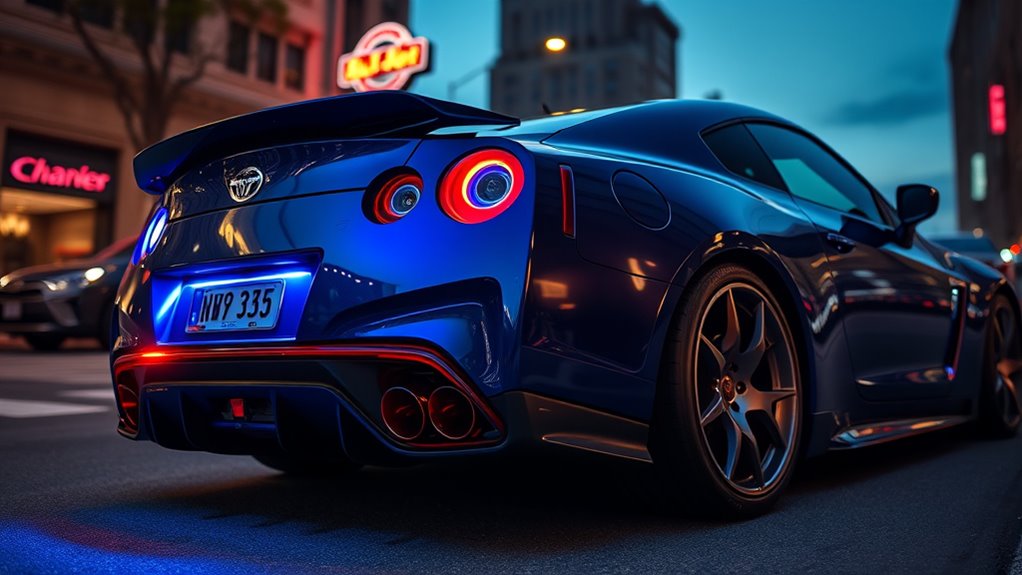
When modifying your vehicle beyond emissions controls, noise, lighting, and visual changes often come into focus.
Noise modifications, like exhaust systems, are regulated by decibel limits that vary by state, with some using sound meters and others relying on officer judgment. Local noise ordinances can also lead to fines if your vehicle is too loud.
For lighting, aftermarket options like LED strips or under-car lights are often illegal, potentially causing inspection failures or traffic tickets.
Visual mods such as window tinting are restricted by state laws, and body kits or altered suspensions must meet safety standards to avoid violations.
Enforcement includes traffic stops and fines, but many issues can be corrected with “fix-it” tickets, helping you stay compliant.
Ensuring Safety and Legal Compliance in Customizations
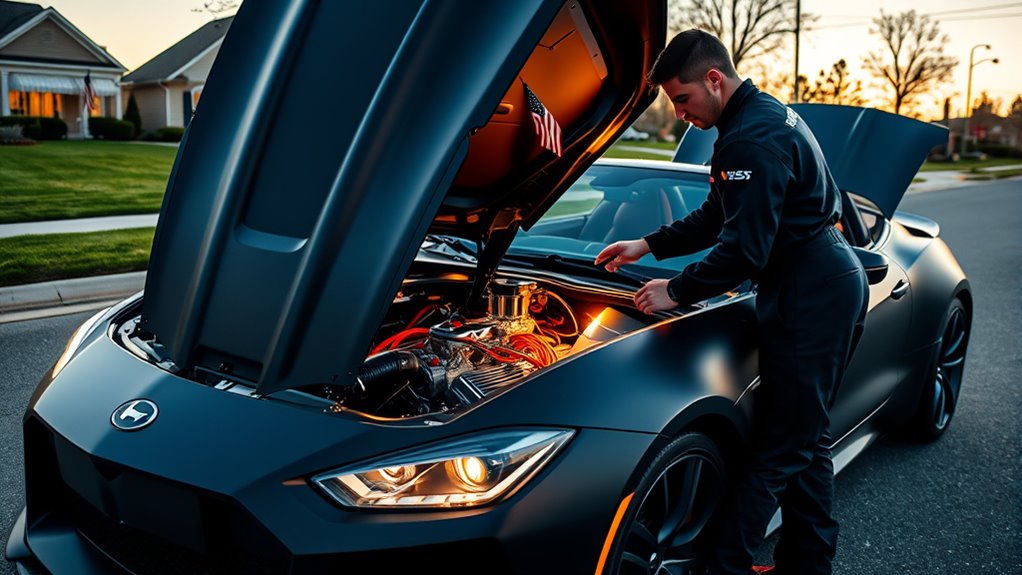
To guarantee your vehicle modifications stay both safe and legal, it’s essential to adhere to federal and state safety standards, such as those outlined by FMVSS. These standards cover critical safety features like fuel system integrity (FMVSS 301), interior flammability (FMVSS 302), occupant protection with seat belts and airbags (FMVSS 208), side-impact resistance (FMVSS 214), and pedestrian collision avoidance (AEB mandates by 2029). Compliance with FMVSS ensures that vehicles meet minimum safety performance requirements, reducing the risk of accidents and injuries. Ensuring compliance involves using crash-resistant materials, maintaining operational doors after a crash, and meeting fire safety standards. Manufacturers must conduct pre-sale testing, provide certification, and monitor ongoing compliance. State laws may restrict emissions tampering, safety equipment modifications, and suspension alterations. Staying informed and documenting your modifications helps guarantee your vehicle remains both safe and within legal boundaries. Additionally, understanding vehicle modification regulations can help owners avoid penalties and ensure their vehicles continue to meet all safety requirements. Being aware of industry standards related to vehicle tuning can also aid in maintaining compliance and safety.
Frequently Asked Questions
Can I Legally Upgrade My Vehicle’s ECU for Better Performance?
You can upgrade your vehicle’s ECU for better performance, but it’s important to guarantee you stay within legal boundaries.
If you modify the ECU without approval, you risk violating emissions laws, especially in states like California.
To stay compliant, look for certified tuning options that meet EPA and CARB standards.
Otherwise, you might face fines, failed inspections, or legal actions.
Always verify your modifications are legal before proceeding.
Are Aftermarket Wheels and Tires Regulated for Legality?
When you’re considering aftermarket wheels and tires, you need to verify they meet federal and state regulations. You must choose rims that comply with NHTSA standards, avoid disabling TPMS, and follow safety and size restrictions.
Additionally, check local laws for emissions and vehicle equipment. Proper installation, documentation, and warnings help you stay legal, while non-compliance can lead to fines, recalls, or voided warranties.
Always verify your modifications align with applicable laws.
Is It Legal to Modify My Vehicle’s Suspension for Off-Road Use?
You wanna modify your vehicle’s suspension for off-road use, but you need to know the rules. Generally, it’s legal to lift your vehicle, but you must follow state-specific laws on height, bumper, and frame modifications.
Make sure your lift doesn’t exceed limits, and your vehicle remains compliant with safety and emissions standards. Failing to do so can lead to fines, impoundment, or insurance issues.
Always check local regulations first.
Can I Install Custom Audio Systems Without Violating Noise Laws?
You can install custom audio systems, but you need to be mindful of noise laws in your area. Many states allow installation, but restrictions often target how loud you play your music, especially outdoors or near residences.
Keep the volume within legal limits, avoid amplifying noise beyond factory levels, and stay aware of local decibel or distance-based restrictions. Otherwise, you risk fines or complaints, so check your local ordinances first.
What Are the Penalties for Illegal Vehicle Modifications?
Did you know that fines for illegal vehicle modifications can reach up to $10,000? You face serious penalties if you break the law, including hefty fines, vehicle impoundment, or even criminal charges.
Severe violations like emissions tampering could lead to misdemeanor or felony charges. Repeated offenses or significant modifications might also result in jail time, a permanent record, or loss of your vehicle, so always stay compliant with local laws.
Conclusion
Think of vehicle tuning as sailing a ship through various waters. Just as a captain must navigate by the stars and follow maritime laws, you need to understand federal, state, and local regulations to keep your modifications legal. By steering carefully through emissions, noise, and safety rules, you avoid dangerous storms and grounding penalties. With knowledge and caution, you can enjoy customizing your ride while staying safely afloat in the legal currents.
